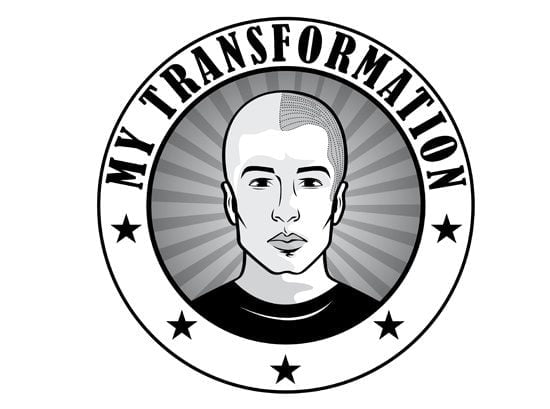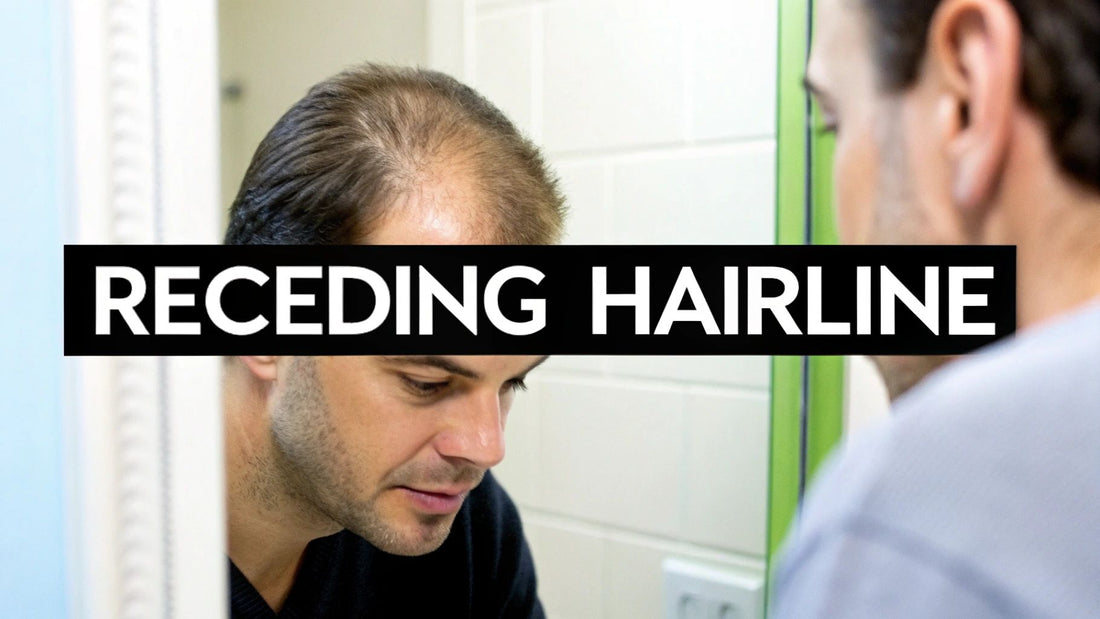
What Causes Receding Hairline? An Australian Guide
Share
Spotting changes along your hairline can be a bit confronting. For most Australian blokes, it’s a mix of genetics, hormones like DHT, and the simple reality of getting older that’s behind it. But figuring out the "why" is the best first step you can take.
Why Your Hairline Is Changing
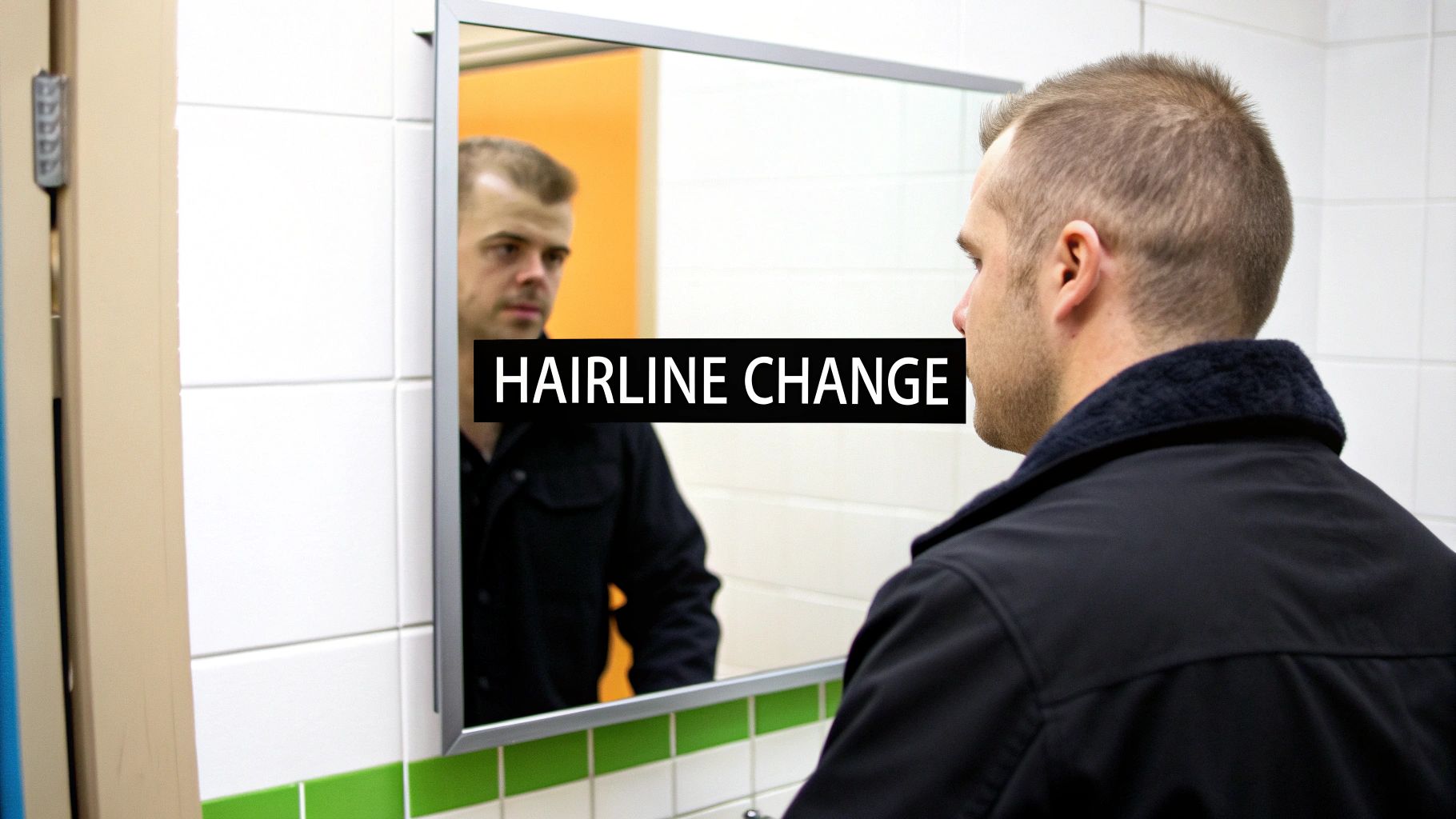
Catching a glimpse of a higher hairline in the mirror can feel like a bit of a shock. But before you jump to conclusions, it’s important to know that not every shift in your hairline spells trouble. There are actually two very different things that could be happening.
First, there's what we call a maturing hairline. This is a completely normal part of ageing for most men. It's a slow, even shift that usually happens in your late teens and twenties, settling down by the time you hit 30. Think of it as your hairline graduating from its teenage shape to its adult form.
Then there's a receding hairline, which is typically the first sign of androgenetic alopecia, more commonly known as male pattern baldness. This isn't just a slight adjustment; it's a progressive type of hair loss that will continue if you don't do anything about it.
The real giveaway is stability. A maturing hairline finds its new spot and stays there. A receding hairline, on the other hand, is driven by your genes and hormones, and it just keeps on marching backwards.
Maturing vs Receding Hairline At a Glance
Getting this distinction right is crucial. Data from right here in Australia shows that understanding the difference is the first hurdle in properly tackling hair loss. A receding hairline caused by male pattern baldness will keep progressing, eventually leading to more widespread thinning. You can find more details on this at hairdoctors.com.au.
To help you figure out what’s going on with your own hair, here’s a quick side-by-side look.
| Characteristic | Maturing Hairline (Natural Aging) | Receding Hairline (Hair Loss) |
|---|---|---|
| Pattern | Moves back evenly, usually less than 2cm | Often creates a distinct 'M' or 'V' shape |
| Speed | Very slow and gradual over many years | Can be noticeable over months or a few years |
| Progression | Stabilises and stops, usually by age 30 | Continues to progress without intervention |
| Associated Thinning | Minimal to no thinning on the scalp | Often accompanied by thinning at the crown |
The science behind all this is fascinating, involving everything from your family tree to the intricate lifecycle of every single hair on your head. If you want to dive a bit deeper into how it all works, you can learn about the hair growth cycle in our detailed guide. Our aim here is to pull back the curtain and make the science behind hair loss easy to understand.
The Genetic Blueprint for Hair Loss
When you start digging into the reasons for a receding hairline, you’ll find that the biggest culprit is almost always written in your DNA. Your genes are essentially the instruction manual for your body, and for a lot of us, that manual includes a very specific chapter on hair loss. This inherited trait is the main driver behind androgenetic alopecia, which you probably know better as male or female pattern baldness.
It's not as simple as a single "baldness gene" though. The reality is far more complex, involving a mix of genes you can inherit from both sides of your family. This is a crucial point that often gets tangled up in old family tales.
The long-standing belief that you only get baldness from your mother's father is just that—a myth. While a key gene for baldness is on the X chromosome (which men get from their mothers), plenty of other genes on different chromosomes also have their say. You can inherit the tendency from either parent.
This genetic programming doesn't make your hair just fall out. Instead, it makes the hair follicles on certain parts of your scalp—usually the temples and crown—extra sensitive to a hormone called Dihydrotestosterone (DHT).
How Genes Create DHT Sensitivity
Think of your hair follicles like tiny locks and DHT as the key. For most people, this key fits just fine and doesn't cause any problems. But if you have a genetic sensitivity, that same key slowly starts to jam the lock.
This "jamming" process is called miniaturisation. It causes the follicle to shrink over time.
With each new hair growth cycle, a genetically sensitive follicle produces a hair that's a little thinner, shorter, and weaker than the last. Eventually, the follicle shrinks so much that it can no longer push out a visible hair. This is what creates the classic signs of a receding hairline and a thinning crown.
The strength of your genetic predisposition dictates how early this process kicks off and how fast it moves. Some guys might see it start in their early twenties, while for others, it might not be noticeable until they hit their forties or fifties.
It's All in the Family
If hair loss is a common theme in your family photos, there's a good chance you'll experience it too. While it's not an absolute guarantee, your family history is the strongest predictor we have. It’s this genetic lottery that decides whether your follicles will overreact to the normal levels of DHT that everyone has.
Understanding this genetic link is the first and most important step. Because the whole process is gradual, catching it early gives you a much better chance of managing it effectively. If you're keen to explore the details, you can learn more about what causes male pattern baldness in our in-depth guide.
At the end of the day, you can't change your genes. But what you can do is take steps to manage their effects. The blueprint might be set, but how you react to it can make a huge difference in keeping your hair healthy. Next, let's look at how the hormonal side of this equation really works.
How Hormones Influence Your Hairline
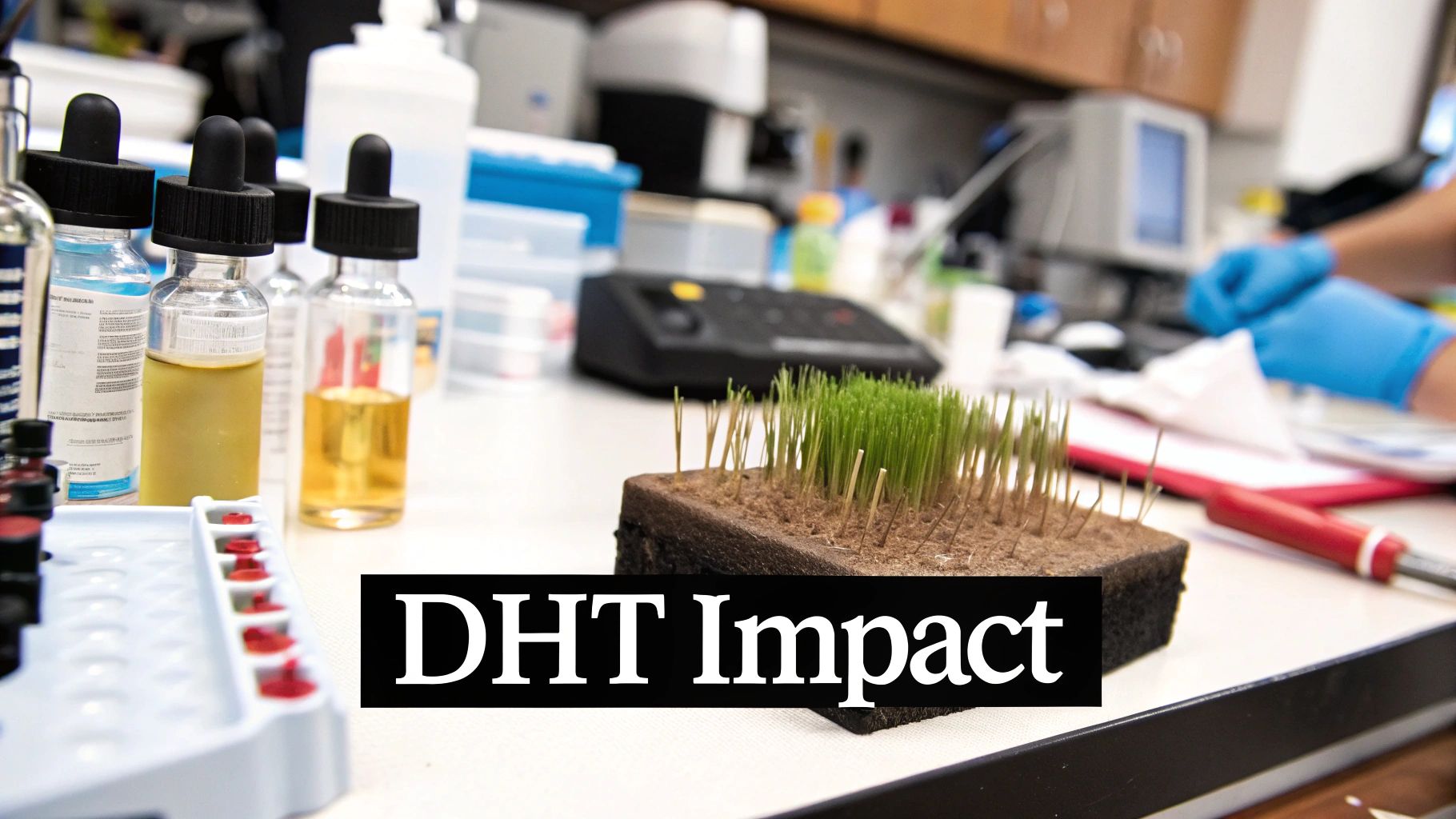
While your genes might load the gun for hair loss, it’s often your hormones that pull the trigger. The main culprit behind a receding hairline is a surprisingly powerful hormone called dihydrotestosterone, or DHT. Getting your head around what it does is the key to understanding why most men experience hair loss.
Think of testosterone as a raw ingredient. Your body uses an enzyme, 5-alpha reductase, to convert a small amount of it into the much more potent DHT. This is a completely normal process that happens in everyone, day in and day out.
The problem arises when you have a genetic sensitivity to DHT. For some men, the hair follicles on their scalp are just extremely receptive to its effects. It’s like having a specific lock on those follicles, and DHT is the only key that fits.
The Miniaturisation Process Explained
When DHT latches onto these sensitive hair follicles, it doesn’t just make the hair fall out overnight. Instead, it kicks off a slow, gradual shrinking process known as follicular miniaturisation.
Picture a healthy hair follicle as a big, robust tree root that produces a thick, strong trunk. In this analogy, DHT is like a poison that slowly chokes that root, weakening it a little more with every growth cycle.
- Cycle 1: The follicle pushes out a hair that’s slightly thinner and shorter than the last one.
- Cycle 2: The next hair to grow is even weaker and has less colour.
- Cycle 3: This continues over and over until the follicle has shrunk so much it can only produce a tiny, see-through “vellus” hair, which is practically invisible.
Eventually, the follicle just gives up and becomes dormant, ceasing hair production entirely. This methodical weakening and shrinking is what you see in the mirror as a receding hairline or a thinning crown.
The crucial thing to realise is that you don't suddenly lose the hair. Instead, your thick, healthy hairs are progressively replaced by smaller, finer versions until they seem to disappear. This is the hormonal engine driving male pattern baldness.
Why Are Only Certain Follicles Affected?
One of the biggest questions people ask is, "Why does it only happen on top?" Why does DHT seem to target the hair on your scalp but leave the sides and back alone? It all comes down to the location of DHT-sensitive receptors.
Put simply, the hair follicles at your temples, hairline, and crown are packed with far more of these receptors than the follicles on the back and sides of your head. This is exactly why the classic “M-shaped” pattern is so common—it perfectly maps out where those vulnerable follicles live. You can get a deeper understanding of these hormonal factors by reading about the link between low testosterone and hair loss.
This hormonal process is precisely what many of the most effective hair loss treatments are designed to combat. Medications like Finasteride, for instance, work by blocking the 5-alpha reductase enzyme. This dramatically reduces how much testosterone gets converted into the follicle-shrinking DHT in the first place. Knowing this is vital when you start looking at your options, as it helps you understand how different treatments work. For example, it’s useful to learn how you can combine treatments with scalp micropigmentation for a more comprehensive approach.
Australian Lifestyle and Environmental Triggers
While your genes and hormones really set the stage for hair loss, your day-to-day life and environment can absolutely put the foot on the accelerator. Think of your genetic predisposition as a pile of dry kindling; things like stress, diet, and sun exposure are the sparks that can set it all ablaze, especially here in Australia.
This infographic breaks down how environmental pressures, particularly from our harsh sun, can take a toll on your hair's health.
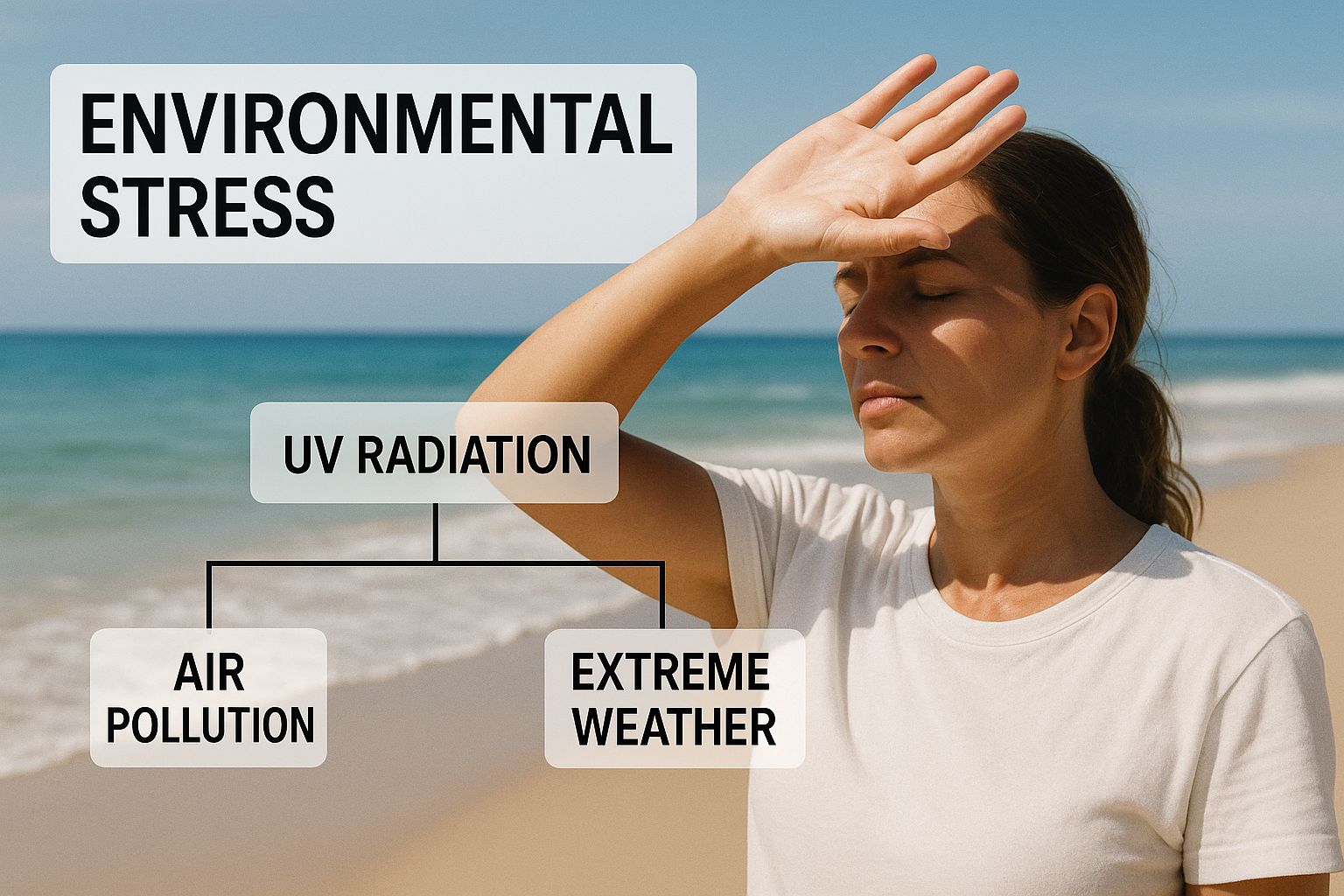
As you can see, external factors are a significant piece of the puzzle, pushing a receding hairline beyond what your DNA might have planned.
The Aussie environment itself is a massive factor. Here, a receding hairline is often a story written by both our genes and our surroundings. By the time they hit 50, about 50% of Australian men are dealing with some form of male-pattern baldness. That number jumps to a staggering 80% by age 70. The intense sun, especially in high-UV places like Queensland, can directly damage hair follicles and potentially fast-track the thinning process.
The Impact of Stress on Your Hair
Chronic stress is one of the biggest lifestyle culprits. When you're constantly under the pump, your body floods itself with the stress hormone cortisol. This hormonal surge can throw your natural hair growth cycle completely out of whack, forcing way more follicles than usual into the shedding (or telogen) phase.
This condition is called telogen effluvium, and it leads to a very noticeable, diffuse thinning all over the scalp. If you already have a genetic tendency for a receding hairline, this can make it look much more pronounced, much faster. It's basically your body's survival mechanism, deciding that growing hair isn't as important as dealing with a perceived threat. This is why managing stress isn't just good for your head; it's critical for your hair. You can dive deeper into the science behind stress-related hair loss in our detailed article.
Nutritional Gaps and Follicle Health
Your hair follicles are like tiny, high-powered factories, and they need a constant supply of raw materials—nutrients—to build strong, healthy hair. If your diet is missing some key vitamins and minerals, you're essentially starving those factories, and their production line will weaken.
Think of your hair like a plant. It doesn't matter how good the seed is (your genetics) if the soil (your body) is lacking essential nutrients. Without the right building blocks, growth will falter.
A few nutrients are absolutely vital for keeping those follicle factories humming along:
- Iron: Crucial for making haemoglobin, which is the taxi service that delivers oxygen to your cells for growth and repair—including the ones that power up your hair follicles.
- Zinc: Plays a huge role in hair tissue growth and repair. It also helps keep the oil glands around the follicles working properly.
- Protein: Hair is almost entirely made of protein. Not getting enough in your diet can lead to brittle, weak strands that are prone to breakage.
- Biotin: This B-vitamin is a fan favourite for hair health, helping your body process the amino acids that form the very structure of your hair.
Making a conscious effort to manage your stress, eat a nutrient-rich diet, and shield your scalp from the harsh Aussie sun can make a real, tangible difference in protecting the hair you've got.
While genetics and hormones are the usual suspects, sometimes a receding hairline is your body's way of waving a red flag. It can be a visible symptom of an underlying health issue that has little to do with typical male pattern baldness. Learning to spot these signs is the first step toward getting the right help.
For instance, your immune system—your personal bodyguard—can sometimes get its wires crossed. In autoimmune conditions like alopecia areata, the body mistakenly attacks its own hair follicles. This can lead to sudden, patchy hair loss that can definitely impact the hairline, often appearing much more rapidly than the slow creep of genetic thinning.
When Your Body Is Out of Balance
Other internal systems can also throw a spanner in the works. Think of your thyroid, that little gland in your neck, as the master regulator of your body's metabolism. If it becomes overactive (hyperthyroidism) or underactive (hypothyroidism), the disruption can send your hair growth cycle into a tailspin, often causing diffuse thinning that makes a receding hairline look much more pronounced.
Beyond this, deficiencies in your diet can starve your hair follicles of what they need to thrive. For example, certain vitamin deficiencies, particularly a lack of iron, zinc, or biotin, can weaken hair production from the root up.
Think of your hair as part of a much larger ecosystem. An unexpected or unusually fast change at your hairline might not be about your hair at all, but a reflection of your overall health.
Medications and Scalp Health
The cause can also be something you're taking to manage a completely different health issue. It’s a well-known fact that certain medications list hair loss as a potential side effect. These can include drugs for:
- Blood pressure
- Depression
- Arthritis
- Cancer (chemotherapy)
And we can't forget the ground your hair grows on: your scalp. Fungal infections or stubborn inflammatory conditions like severe dandruff can create a hostile environment for hair follicles, sometimes contributing to hair fall. If this is a concern, it's worth exploring whether dandruff can cause hair loss and what steps you can take.
To help you get a clearer picture of all the potential factors, here's a quick summary.
Potential Contributors to Hairline Recession
| Cause Category | Primary Examples | Is It Reversible? |
|---|---|---|
| Genetics & Hormones | Male/Female Pattern Baldness, DHT sensitivity | Usually progressive, but can be managed with treatment. |
| Autoimmune Conditions | Alopecia Areata, Lupus | Often yes, once the underlying condition is managed. |
| Systemic Health Issues | Thyroid disorders, severe stress, nutritional gaps | Yes, in most cases, by addressing the root health problem. |
| Lifestyle & Environment | Poor diet, smoking, harsh hair treatments | Yes, by making positive lifestyle changes. |
| Medications | Chemotherapy, blood pressure medication, antidepressants | Often yes, after stopping or changing the medication. |
| Scalp Conditions | Fungal infections, severe dandruff, psoriasis | Yes, once the scalp condition is effectively treated. |
This table shows that while some causes are genetic, many are linked to treatable health or lifestyle factors.
In Australia, the early onset of a receding hairline is surprisingly common, with stats showing around 20% of men in their 20s notice some degree of thinning. While it’s often genetic, it’s worth remembering that even male pattern baldness has been linked to broader health concerns like heart disease. It all points back to the same idea: your hair is a barometer for your overall wellbeing. If your hair loss feels unusual, a chat with your doctor is always the best next step.
A Few Common Questions About Receding Hairlines
Even with a good grasp of the causes, you've probably still got a few nagging questions about what a receding hairline actually means for you. Let's tackle some of the most common ones we hear, cutting through the noise to give you straight-up, practical answers.
Can You Actually Stop or Reverse a Receding Hairline?
This is the million-dollar question, isn't it? The honest answer is: it really depends on what’s causing it in the first place. If your receding hairline is down to androgenetic alopecia (your classic genetic pattern baldness), then acting early is your best weapon.
Clinically proven treatments like Minoxidil and Finasteride can do a remarkable job of slowing things down. For a lot of guys, they can even kick-start some regrowth. The key is that they work best when the hair follicles are just dormant, not completely gone for good.
But if your hair loss is being triggered by something like intense stress or a gap in your nutrition, you're in a different boat. Fix the root cause, and there's a good chance your hair will start to grow back. The first step is always getting a proper diagnosis from a doctor to figure out what you’re really up against.
Does Wearing a Hat Make Your Hairline Recede?
This myth just refuses to die, but let's be clear: no, wearing a hat will not cause the genetic, hormone-driven hair loss we associate with a receding hairline.
For a hat to actually cause hair loss, it would have to be clamped on so tight that it physically choked off the blood supply to your hair follicles. That’s just not going to happen with your average cap. The only time pulling causes hair loss is with traction alopecia, which is a result of constant, severe tension from things like tight cornrows or man buns.
So go ahead, wear your favourite hat. Unless it’s causing you genuine pain, it’s not the villain here. Your genetics are the ones calling the shots.
At What Age Is It Normal to See Your Hairline Receding?
It’s really important to distinguish between a maturing hairline and a receding one. A maturing hairline is a completely normal part of growing up for most blokes, usually happening sometime between your late teens and late twenties. It’s just a slight, even shift backwards of about 1-2 centimetres that then stops.
A true receding hairline from male pattern baldness can also kick off in the late teens or early twenties, but the big difference is that it keeps going. Australian stats show that around 20% of men see noticeable hair loss by the time they hit their 20s. So while it definitely gets more common as you get older, an early start isn't unusual if the predisposition is in your genes.
Are There Any Natural Remedies That Genuinely Work?
You'll find countless "natural cures" for hair loss online, but the scientific evidence for most of them is pretty thin compared to medically approved treatments.
While some natural approaches can be helpful, they are very unlikely to reverse a genetically driven receding hairline all on their own.
- Scalp Massages: Feels great and can boost blood flow to the scalp, which is always a good thing for follicle health. But it won't stop the effects of DHT.
- Essential Oils: Rosemary oil has shown a bit of promise in some small studies, with some suggesting it could be comparable to a low-strength 2% minoxidil. The results are far from consistent, though.
- A Balanced Diet: This one is non-negotiable. Getting enough iron, zinc, biotin, and protein gives your hair the raw materials it needs to grow strong.
The best way to think about these natural strategies is as a supporting cast. They are fantastic for complementing a primary treatment plan from a doctor, but they probably won't solve the problem on their own.
At My Transformation, we know that dealing with hair loss is a deeply personal journey. We specialise in Scalp Micropigmentation (SMP), a brilliant solution that recreates the look of a full head of hair, helping you get back the confidence you deserve. If you're ready to look into a lasting and effective option, we'd love to show you what's possible.
